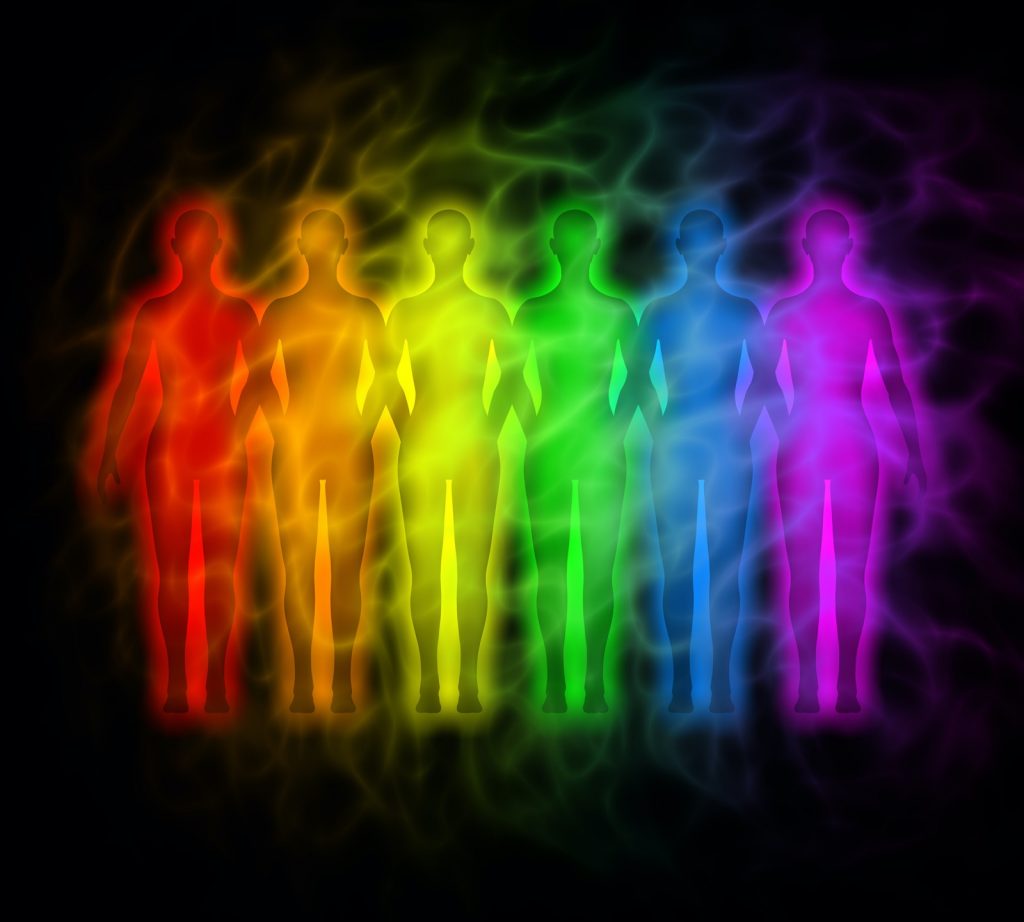Overall, an aura is an energy field that surrounds humans, animals, or objects. Then what are aura colors?
WHAT ARE AURA COLOURS?
Aura colors are basically thought of as unseen fields of energy surrounding us. Our aura color affects our mood and our emotional state (and sometimes the state of others). Generally, we have different aura colors expressing different emotions and qualities. What are these aura colors, though?
AURA COLOUR
Basically, auras are represented by different colors. Many people believe that these aura colors tell us how emotionally, physically, and, more importantly, spiritually complex we are. But personally, I don’t think that’s the case. Because one person can have fluctuating auras, from pink to blue or violet to green. Not every single thing can be fully automated by science.

We have;
1. White
2. Pink
3. Teal
4. Green
5. Red
6. Violet
7. Grey
8. Black
9. Brown
10. Orange
11. Yellow
12. Blue
13. Indigo
AURA COLOURS MEAN CHART
Generally, on the aura color chart, we have;
#1. White:
The white aura color depicts balance. Plainly said, a well-balanced personality. It is often regarded as the crystal aura because it’s pure and transparent. Overall, people with this type of aura may tend to take on the energy of others.
#2. Grey:
Grey auras can denote pessimism. There are two types of people. The ones who see a glass as half full then the other as half empty. Anyone with a grey aura would much rather look at the glass as half empty than the other way around. They also have trouble opening themselves up to new possibilities or ideas.
#3. Brown:
The brown aura is known for insecurities or selfishness. However, the brown aura is majorly insecure. However, as a brown aura, you can learn to always give to others instead of taking. When you do that, you’re cleaning up your aura.
#4. Black:
Similar to the color “black,” it denotes dark energy usually brought on by unkind behavior. Without a doubt, this aura’s appearance indicates that the person needs to let go of baggage that is inhibiting them from radiating positivity in their lives.
#5. Red:
The red aura is all about passion, and it is driven by emotions, desires, and feelings. Anyone with a red aura is very creative and always ready to manifest new goals because of their emotional drive. Additionally, red auras are all about being physical. For example, they easily get angry and might probably get physical, but after that, they let it go. They usually feel an extreme rush of emotions than any other auras.
#6. Pink:
Someone who easily gives his or her heart to people they love has a pink aura. But even as a pink aura, make sure your giving energy is reciprocated by those you care about.
#7. Orange:
Like the red aura, the orange aura is known for its creativity. As an orange aura, your mind can be overactive. When you get that way, don’t fret. With that kind of mind, you can easily piece ideas together and make them a reality.
#8. Yellow:
High energy levels and optimism. That sums up the yellow aura to a tee. Some yellow auras tend to live in the present without stressing about the future.
#9. Green:
Green auras are known for their hard work. Generally, they are builders and nature lovers. Like most auras, they also have a downside. The green aura downside may be prone to jealousy or competition.
#10. Blue:
Generally, blue auras are known for being emotionally sensitive and emotionally sophisticated. They are also quite expressive. You have to be more attentive when dealing with a blue aura. Because they are really in touch with their feelings.
#11. Teal:
Like the blue auras, they are quite sensitive. Change can be a little frightening to a teal aura, though. As such, that closes them off to new opportunities or experiences.
#12. Indigo:
An indigo aura denotes a wise person with an old soul. They escape into their secret world to protect their energy, minds, and hearts from others.
#13. Violet:
The urge to merge with another is important to a violet aura, as they constantly seek deep connection. Spiritual awareness, emotional awareness, and psychic sentiments are pointers to the violet aura.
RARE AURA COLOURS
The rarest of all aura colors is the white aura. Well, because it is almost impossible to find someone well-balanced without any emotional neediness. In lay terms, the white aura is just perfect. But in the real world, no one is truly perfect.
HOW TO READ MY OWN AURA
Anyone can read an aura, though. It’s all about trusting your intuition. How do I read my aura, though? You’d need a mirror for this.
a. Look into the mirror for a minute in front of a white background.
b. Concentrate on a point in the middle of your forehead.
c. Without moving your eyes, scan the outer perimeter of your head and shoulders.
d. Without a doubt, the color you see surrounding your head and shoulders is your aura.
HOW CAN I TELL IF MY AURA IS COMPATIBLE WITH OTHER PEOPLE’S?
Just like zodiac signs, some aura colors tend to be more compatible with some than others. We have;
a. as a white aura, you can be compatible with any other energy. But be careful not to taint your aura by absorbing bad energy from those around you.
b. When you have a black aura, then a golden aura or a yellow aura. Because it’d serve as healing energy for you both.
c. If you have a brown aura, a light green aura will serve to open your heart.
d. Generally, red auras work perfectly with a bright green aura. It will help you both manifest passions into reality in general.
e. If you have an orange aura, a dark blue aura will boost positive vibes between you both.
f. If you have a green aura, adding a lilac aura will make you both more spiritually inclined.
g. When you have a blue aura, then the addition of a pink aura will lead to creating greatness together.
h. a yellow aura, adding a vibrant purple aura, will help inspire and motivate you both towards artistic ventures.
i. Violet auras tend to do better with a red aura.
AURA COLOURS TEST
This scientifically researched test will help you determine your aura color to balance out what we have previously discussed. Choose only one answer for each of the following questions.
#1. Which of the following most closely describes your personality?
a) Energetic and forceful
b) Thoughtful and considerate
c) Healthy and friendly
d) Sociable and a people person
e) Caring and helpful
f) Spiritual and humble
g) Tender and sympathetic
#2. In general, this statement fits you:
a) I am angry easily.
b) I like physical activities.
c) I dislike rules.
d) I communicate easily.
e) I love to help others.
f) I daydream.
g) I enjoy learning new things.
#3. Overall, you would describe yourself as:
a) A loner
b) A risk-taker
c) Spontaneous
d) A nature lover
e) A good listener
f) A visionary
g) Extremely sensitive
#4. Overall, you are:
a) Realistic
b) Confident
c) Optimistic
d) Outgoing
e) Intuitive
f) Curious
g) Idealistic
#5. Others say you are:
a) Well-grounded
b) Brave
c) Creative
d) Love-centric
e) Highly Spiritual
f) Imaginative
g) Independent
Here are your test results:
1. If most of your answers were “A”, then your aura is red.
2. If your answers were predominantly “B”, you have an orange aura.
3. If most of your answers were “C”, then your aura is yellow.
4. If all or most of your answers were “D”, then without a doubt, your aura is green.
5. If a majority of your answers were “E”, your aura is blue.
6. If all your answers were “F”, then your aura is indigo.
7. If most of your answers were “G”, congrats, your aura is violet.
When most of your answers are evenly divided between two or three colors, your aura color fluctuates depending on your mood.
Are auras real?
Yes, but the interpretation of what an aura is varies among practices and philosophies. But basically, it is about human energy.
How do you photograph an aura?
Aura photography requires special equipment, including a camera, two hand plates, a dark background, and a dark space to shoot in. The equipment itself can cost upwards of $16,000.
CONCLUSION
Note that each layer of your aura is said to correspond to a different chakra. What is a chakra?
Chakras are different realms of energy within your body. Some layers or chakras, however, are more dominant. Others may be less visible and less easily sensed. This is a factor that contributes to our aura colors.



